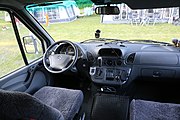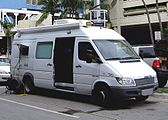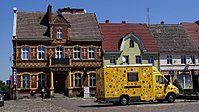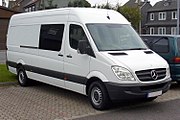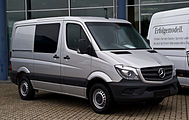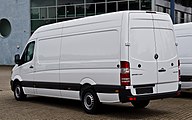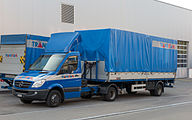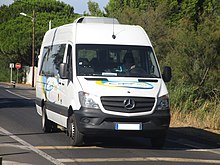Mercedes-Benz Sprinter
| Mercedes-Benz Sprinter | |
|---|---|
| Manufacturer: | Daimler AG |
| Production period: | 1995 – today |
| Previous model: | Mercedes-Benz T 1 |
| Successor: | none |
| Similar models: |
Fiat Ducato Ford Transit Renault Master VW LT (Generation 2) VW Crafter |
The Mercedes-Benz Sprinter is a van of the Mercedes-Benz brand from Daimler AG . In 1995 it succeeded the Mercedes-Benz T 1 ("Bremer Transporter") and was also voted Van of the Year in 1995 . From 2006 the Sprinter was in its second generation. The third generation came on the market in June 2018. In North America, the Sprinter is sold both under the Mercedes-Benz brand and as a Freightliner . At times it was also offered under the Dodge brand . The Sprinter was also offered as a VW LT (Generation 2) from 1996 to 2016 - equipped with different engines and slightly modified on the outside . The VW Crafter has been around since 2017 , both of which are an in-house development of the Volkswagen Group. The Crafter is also available as an identically constructed MAN TGE .
T1N 1995-2006 (W 901-905)
| W 901-905 | |
|---|---|

Mercedes-Benz Sprinter (1995-2000) |
|
| Production period: | 1995-2006 |
| Designs: | Panel van , minibus |
| Engines: |
Otto engine : 2.3 liters (105 kW) Diesel engines : 2.2–2.9 liters (58–115 kW) |
| Length: | 4970-6525 mm |
| Width: | 1935 mm |
| Wheelbase: | 3000-4025 mm |
| Perm. Total weight: | 2.8-6.0 t |
The first generation of the completely redeveloped Sprinter was outwardly very different from the previous model (“Bremer Transporter”). What is striking is the sloping bonnet in contrast to the angular "snout" of the T1. The Sprinter was offered with three different wheelbases and two different heights and offers a transport volume of up to 17 cubic meters.
The Sprinter was developed in collaboration with Volkswagen and is therefore offered by VW under the brand name VW LT and as a Sprinter for Mercedes-Benz , Dodge and Freightliner by Daimler . While the Sprinter experienced several facelifts in its life cycle, the VW LT has been produced practically unchanged since the start of production. That was one of the reasons why the Sprinter sold far better than the LT, its name practically defining the class of large vans. The Sprinter was produced in the Mercedes-Benz plants in Düsseldorf , Buenos Aires (Argentina) and in Ho Chi Minh City in Vietnam ( CKD assembly).
During the first facelift in February 2000, the front section in particular was changed. The Mercedes star now protruded into the hood and the headlights and indicators were designed to be more streamlined. The dashboard has been completely redesigned including a new instrument cluster and a gearshift lever integrated into the dashboard. In addition, the electrical system was converted to CAN bus . During the second facelift in autumn 2002, the radiator grille got a frame painted in the color of the car and the taillights were made in two colors.
After 2006, the T1N was still being built at the Mercedes-Benz plant in Argentina for some export markets. In Egypt , Algeria , Brazil and Sudan , however, Manufacturing Commercial Vehicles continued to produce the T1N for a few years.
The type designation W 901 describes the first series from 1995 to 1997. From 1998 the vehicles were given the type designations W 902 to W 905, depending on the permissible total weight of the respective vehicle. So models 2 ** = W 902, 3 ** = W 903, 4 ** = W 904 and 6 ** = W 905. The asterisks of the models are due to the engine power to a rounded 10 HP, with omission of the last digit " 0 ”to replace.
The same engines are available for the Sprinter W 901, W 902, W 903 and W 904, model designation starting with the number 2, 3 or 4.
Technical specifications
| 214 314 414 |
208 D 308 D 408 D |
208 CDI 308 CDI 408 CDI |
211 CDI 311 CDI 411 CDI |
213 CDI 313 CDI 413 CDI |
210 D 310 D 410 D |
212 D 312 D 412 D |
216 CDI 316 CDI 416 CDI 616 CDI |
||
|---|---|---|---|---|---|---|---|---|---|
| Construction period | 1995-2000 | 2000-2006 | 1995-2000 | 2000-2006 | 1997-2000 | 1995-2000 | 2000-2006 | ||
| Engine characteristics | |||||||||
| Engine series | M 111 E 23 | OM 601 D 23 | OM 611 DE 22 LA | OM 602 DE 29 LA | OM 612 DE 27 LA | ||||
| Engine identification | 111,979 | 111,984 | 601.943 | 611.987 | 611.981 | 602.980 | 612.981 | ||
| Engine type | R4 petrol engine | R4 diesel engine | R5 diesel engine | ||||||
| Number of valves per cylinder | 4th | 2 | 4th | 2 | 4th | ||||
| Valve control | DOHC , chain | OHC, chain | DOHC, chain | OHC, chain | DOHC, chain | ||||
| Mixture preparation | Manifold injection |
Pre-chamber injection |
Common rail injection | Direct injection | Common rail injection | ||||
| Engine charging | - | turbocharger | Turbocharger , intercooler | turbocharger | Turbocharger, intercooler | ||||
| cooling | Water cooling | ||||||||
| Bore × stroke | 90.9 mm x 88.4 mm | 89.0 mm × 92.4 mm | 88.0 mm x 88.3 mm | 89.0 mm × 92.4 mm | 88.0 mm x 88.3 mm | ||||
| Displacement | 2295 cc | 2299 cc | 2148 cc | 2874 cc | 2685 cc | ||||
| Compression ratio | 10.4: 1 | 22.0: 1 | 18.0: 1 | 19.5: 1 | 18.0: 1 | ||||
| Max. Power at min −1 | 105 kW (143 PS) / 5000 |
58 kW (79 PS) / 3800 |
60 kW (82 PS) / 3800 |
80 kW (109 PS) / 3800 |
95 kW (129 PS) / 3800 |
75 kW (102 PS) / 3400 |
90 kW (122 PS) / 3800 |
115 kW (156 PS) / 3800 |
|
| Max. Torque in min -1 | 210 Nm / 4000 |
215 Nm / 3200-4700 |
152 Nm / 2300-3000 |
200 Nm / 1400-2600 |
270 Nm / 1400-2400 |
300 Nm / 1600-2400 |
250 Nm / 2000 |
280 Nm / 2000-2300 |
330 Nm / 1400-2400 |
| Power transmission | |||||||||
| Drive, as standard | Rear wheel drive | ||||||||
| Drive, optional | - | all wheel drive | - | all wheel drive | - | all wheel drive | |||
| Gearbox, as standard | 5-speed manual transmission | ||||||||
| Gearbox, optional | 4- speed automatic transmission | - | 6-stage sprint shift | 4-speed automatic transmission | 6-step sprint shift | ||||
| 5- speed automatic transmission |
|||||||||
| Readings | |||||||||
| Top speed | 136-169 km / h | 150-160 km / h | 110-137 km / h | 120-135 km / h | 135-145 km / h | 150–155 km / h | 130-145 km / h | 119-160 km / h | 145-160 km / h |
| Fuel consumption over 100 km (combined) | 12.6 l p | 10.7 l D. | 8.5-8.9 ID | 8.7 l D | |||||
| CO 2 emissions (combined) | 301 g / km | 282 g / km | 224-236 g / km | 228 g / km | |||||
- ↑ 616 CDI only available from 2001.
- The availability of the engines depended on the model, equipment and market.
Mercedes-Benz 412 D in use as a bus in Dortmund
Mercedes-Benz Sprinter T1N Russia from 2013
On June 22, 2012, Mercedes-Benz announced that from mid-2013 up to 25,000 units of the Sprinter T1N would be built by Gorkowski Avtomobilny Sawod (GAZ) in their main plant for the Russian market. These are to be sold through the Russian Mercedes-Benz dealer network.
NCV 3 2006-2018 (W 906)
| W 906 | |
|---|---|

Sprinter station wagon (2006-2013) |
|
| Production period: | 2006-2018 |
| Designs: | Panel van , minibus |
| Engines: |
Otto engines : 1.8–3.5 liters (115–190 kW) Diesel engines : 2.2–3.0 liters (65–140 kW) |
| Length: | 5245-7345 mm |
| Width: | 1993 mm |
| Height: | 2435-3055 mm |
| Wheelbase: | 3250-4325 mm |
| Payload: | 1.93-2.84 t |
| Perm. Total weight: | 3.0-5.0 t |
NCV 3 (New Concept Van) is the internal name for the second generation of the Mercedes-Benz Sprinter, which was produced from April 2006 to the beginning of 2018.
The series of box vehicles and station wagons (closed models) have been produced at the Mercedes-Benz plant in Düsseldorf since 2006. The so-called "open model" (driver's cab and double cab) of the Sprinter are produced by Mercedes-Benz Ludwigsfelde GmbH south of Berlin. In the case of an open model, a flatbed or any other structure is mounted on the rear part of the chassis.
Furthermore, all four models are built at the Mercedes-Benz González Catán plant in Argentina . In the People's Republic of China , Mercedes-Benz Commercial Vehicle is the only European van manufacturer to produce the Sprinter with its own production facility in China. The Sprinter is manufactured in Fuzhou in the body and assembly plant of Fujian Benz Automotive, a joint venture between Mercedes-Benz Vans and Fujian Motors Group . The products produced there include the Mercedes-Benz Vito , Viano and Sprinter in the bus variant. In addition, together with authorized body manufacturers various industry solutions offered or mounted, for example, ambulances ( ambulance ) or police vehicles ( Police Car ). The vehicles are not sold through the Mercedes-Benz passenger car sales network, but rather through a Chinese partner who has a separate dealer network that specializes only in Mercedes-Benz van products.
The Mercedes-Benz Sprinter is available in different body versions: with three wheelbases (3250/3665/4325 mm) and in four lengths from 5243 to 7343 mm; the box bodies are available with a normal roof, high roof and the new super high roof. With a gross vehicle weight of 2.0 to 5.0 tonnes , the new Sprinter covers all key segments in its class. Among other things, flatbed chassis for a permissible total weight of three to five tons and chassis for special bodies (such as for ambulances or parcel service) as well as low frames for mobile homes are offered as open models. The superstructures often come from third-party manufacturers, some of whom specialize in it.
Further possible variations in the configuration of a Sprinter are a normal or double cab, the presence of a rear wall of the cab, a so-called double driver's seat as well as different rear axle ratios and leaf spring variants on the rear axle.
The different wheelbases, lengths, heights, weights, body, engine and transmission configurations result in around 1000 possible basic configurations ex works.
A significant advantage over its predecessor is the wider and higher loading space sliding door, which enables euro pallets to be loaded across, which means that the loading space is better utilized. The sliding door can also be operated electrically for a surcharge.
The Sprinter is offered with 4 or 6 cylinder diesel engines and a V6 petrol engine. A 6-speed manual transmission and a 5-speed automatic transmission are available as transmissions . ESP is standard equipment. The Mercedes-Benz Sprinter 316 NGT, a natural gas vehicle with a bivalent drive, has also been on the market in Europe since May 2008 .
In the early summer of 2009 , the 4-cylinder diesel engines of the OM 646 series were replaced by the OM 651 known from the C and E-Class , which was coupled to a six-speed manual transmission specially designed for commercial vehicles (EcoGear 360 for four-cylinder, EcoGear 480 for six-cylinder) is. While the two more powerful versions in the 313 CDI and 316 CDI are charged by two turbochargers with adjustable turbine guide vanes , the smaller model 309 CDI has only one load-dependent charger. With the conversion to the new four-cylinder generation, the 109 hp variant was no longer available. The output of the six-cylinder OM 642 has been increased slightly to 140 kW (190 hp), while no changes have been made to the gasoline engines. Together with the CDI diesel engines, a 7-speed automatic transmission (7G-Tronic) has been available since the first quarter of 2012. Mercedes-Benz already uses this transmission in various other vehicles of the brand.
In September 2013, all Sprinter models were revised. Features of this facelift are the changed front and improved engines, all of which now meet the Euro 6 emissions standard and whose consumption has been reduced by 30 mm, among other things, by lowering the body. From now on, a crosswind assistant is standard to help the driver stay in lane. The assistance system Collision Prevention Assist warns a distracted driver optically and acoustically and prepares the adaptive brake assistant for an upcoming braking. The Assyst maintenance interval display is part of the standard equipment. The maintenance interval for the diesel variants has been extended to up to 60,000 kilometers.
From September 2016, the Sprinter will also be available in a 5.5-ton version, which increases the payload by up to 450 kg. The maximum output of the two smaller engine variants of the OM 651 diesel engine has been increased. The previous 70 kW version (95 PS, 250 Nm) increased to 84 kW (114 PS, 300 Nm), the 95 kW version (129 PS, 305 Nm) to 105 kW (143 PS, 350 Nm). The other diesel engines (120 kW, OM 651 and 140 kW, OM 642) remained unchanged.
The Sprinter is available with various body variants from third-party manufacturers and from the Dortmund factory as a minibus in the variants Mobility, Transfer, Travel and City with up to thirty seats.
Engines
| model | Engine identification code |
engine | Displacement | power | Torque | construction time |
|---|---|---|---|---|---|---|
| Diesel engines | ||||||
| 209 CDI / 309 CDI / 409 CDI | OM 646 DE 22 LA | Row 4 | 2148 cc | 65 kW (88 PS) at 3800 rpm | 220 Nm at 1600-2600 rpm | 2006-2009 |
| 210 CDI / 310 CDI / 510 CDI | OM 651 DE 22 LA | Row 4 | 2143 cc | 70 kW (95 PS) at 3800 rpm | 250 Nm at 1400-2400 rpm | 2009–05 / 2016 |
| 210 BlueTEC / 310 BlueTEC / 510 BlueTEC | OM 651 DE 22 LA | Row 4 | 2143 cc | 70 kW (95 PS) at 3800 rpm | 250 Nm at 1400-2400 rpm | 2013–05 / 2016 |
| 211 CDI / 311 CDI / 411 CDI / 511 CDI | OM 646 DE 22 LA | Row 4 | 2148 cc | 80 kW (109 PS) at 3800 rpm | 280 Nm at 1600-2400 rpm | 2006-2009 |
| 211 CDI / 311 CDI / 411 CDI / 511 CDI | OM 651 DE 22 LA | Row 4 | 2143 cc | 84 kW (114 hp) at 3800 rpm | 300 Nm at 1200-2200 rpm | since 06/2016 |
| 213 CDI / 313 CDI | OM 646 DE 22 LA | Row 4 | 2148 cc | 95 kW (129 hp) at 3800 rpm | 305 Nm at 1200-2400 rpm | 2006-2009 |
| 213 CDI / 313 CDI / 513 CDI | OM 651 DE 22 LA | Row 4 | 2143 cc | 95 kW (129 hp) at 3800 rpm | 305 Nm at 1200-2400 rpm | 2009–05 / 2016 |
| 213 BlueTEC / 313 BlueTEC / 413 BlueTEC / 513 BlueTEC | OM 651 DE 22 LA | Row 4 | 2143 cc | 95 kW (129 hp) at 3800 rpm | 305 Nm at 1200-2400 rpm | 2013–05 / 2016 |
| 214 CDI / 314 CDI / 514 CDI | OM 651 DE 22 LA | Row 4 | 2143 cc | 105 kW (143 hp) at 3800 rpm | 330 Nm at 1200-2400 rpm | since 06/2016 |
| 215 CDI / 315 CDI / 415 CDI / 515 CDI | OM 646 DE 22 LA | Row 4 | 2148 cc | 110 kW (150 PS) at 3800 rpm | 330 Nm at 1200-2400 rpm | 2006-2009 |
| 216 CDI / 316 CDI / 416 CDI / 516 CDI | OM 651 DE 22 LA | Row 4 | 2143 cc | 120 kW (163 hp) at 3800 rpm | 360 Nm at 1400-2400 rpm | since 2009 |
| 216 BlueTEC / 316 BlueTEC / 416 BlueTEC / 516 BlueTEC | OM 651 DE 22 LA | Row 4 | 2143 cc | 120 kW (163 hp) at 3800 rpm | 360 Nm at 1400-2400 rpm | since 2013 |
| 218 CDI / 318 CDI / 418 CDI / 518 CDI | OM 642 DE 30 LA | V 6 , 72 ° | 2987 cc | 135 kW (184 hp) at 3800 rpm | 400 Nm at 1600-2600 rpm | 2006-2009 |
| 219 CDI / 319 CDI / 419 CDI / 519 CDI | OM 642 DE 30 LA | V 6, 72 ° | 2987 cc | 140 kW (190 PS) at 3800 rpm | 440 Nm at 1600-2600 rpm | 2009-2013 |
| 219 BlueTEC / 319 BlueTEC / 519 BlueTEC | OM 642 DE 30 LA | V 6, 72 ° | 2987 cc | 140 kW (190 PS) at 3800 rpm | 440 Nm at 1400-2400 rpm | since 06/2013 |
| Petrol engines | ||||||
| 216/316 | M 271 E 18 ML | Row 4 | 1796 cc | 115 kW (156 hp) at 5000 rpm | 240 Nm at 3000-4000 rpm | since 2008 |
| 316 NGT | M 271 E 18 ML | Row 4 | 1796 cc | 115 kW (156 hp) at 5000 rpm | 240 Nm at 3000-4000 rpm | since 2008 |
| 224/324/424/524 | M 272 E 35 | V 6, 90 ° | 3498 cc | 190 kW (258 hp) at 5900 rpm | 340 Nm at 2500-5000 rpm | 2006-2013 |
- ↑ 513 CDI available since September 2013.
The same engines are available for Sprinters with a gross vehicle weight of 3.5 tonnes or more, model designation starting with the number 3, 4 or 5.
Mercedes-Benz Minibus GmbH
In 1998 EvoBus took over a minority stake in the bodybuilder Karl Koch GmbH in Mudersbach , and since the beginning of 2004 the company has been wholly owned by Daimler and operates as Mercedes-Benz Minibus GmbH . Before that, the company had already manufactured minibuses based on the Sprinter and Vario at several locations , operations were concentrated in Dortmund and production expanded.
Four product lines will be manufactured in 2020: Transfer , Travel , City and Mobility . For the smaller models (up to 45), a van is used as the basis and removed, so the external dimensions are retained. The large models use a low-frame chassis with an independent structure made of GRP on a supporting frame. In the past there were also medium-sized models based on a panel van with a rear extension made of GRP (55) and the top city model 77 had a driven rear tandem axle with independent suspension. With the generation change of the Sprinter 2018, the program was adjusted to include some overly complex models. In addition to the expanded panel van in the standard dimensions of the Sprinter, the model 75 (City and Travel) is also being built, which at 8.5 meters is around 1.1 m longer than the longest panel van or the model 45.
Sprinter transfer
The Sprinter Transfer represents the link between the Sprinter in the Tourer equipment and the more elaborate minibuses Travel and City. Since the generation change in 2018, the Transfer 23 has only been offered as a right-hand drive.
| W906 models | Passenger capacity | Dimensions (mm) | Perm. Weight |
engine | |||||||
|---|---|---|---|---|---|---|---|---|---|---|---|
| Seats | Wheelchairs | length | width | height | wheelbase | Type | Power kW) | ||||
| Mercedes-Benz Sprinter Transfer 23 | 12 | ~ 0 | ~ 5926 | ~ 1993 | ~ 2850 | ~ 3665 | ~ 3.5 t | OM 651 | ? | ||
| Mercedes-Benz Sprinter Transfer 34 | 14th | 6961 | 1993 | 2850 | 4325 | 4.0 t | 95 | ||||
| Mercedes-Benz Sprinter Transfer 45 | 19th | 7361 | 2920 | 5.0 t | 120 | ||||||
| Mercedes-Benz Sprinter Transfer 55 | 22nd | 7681 | ? | ||||||||
| The information marked with "~" is derived / estimated. | |||||||||||
| Models W907 / W910 | Passenger capacity | Dimensions (mm) | Perm. Weight |
engine | |||||
|---|---|---|---|---|---|---|---|---|---|
| Seats | Wheelchairs | length | width | height | wheelbase | Type | Power kW) | ||
| Mercedes-Benz Sprinter Transfer 23 | 13 | - | 5932 | 2020 | 2790 | 3665 | 3.55 t | OM 651 | 84-120 |
| Mercedes-Benz Sprinter Transfer 35 | 16-19 | 6967 | 4325 | 5.0 t | 105-140 | ||||
| Mercedes-Benz Sprinter Transfer 45 | 19-22 | 1 | 7367 | ||||||
Sprinter Travel
The Sprinter Travel is designed by the manufacturer as a touring coach. Since the generation change in 2018, the transfer models have taken on the role of the smaller travel models and, conversely, the new Travel 75 that of the larger transfer models. The Sprinter Travel is supplied with an automatic transmission as standard.
| W906 models | Seats | Dimensions (mm) | Perm. Weight |
engine | ||||
|---|---|---|---|---|---|---|---|---|
| length | width | height | wheelbase | Type | Power kW) | |||
| Mercedes-Benz Sprinter Travel 45 | 16 | 7361 | 1993 | 2920 | 4325 | ? | OM 651 | 120 |
| Mercedes-Benz Sprinter Travel 55 | 18th | 7681 | 2900 | ? | ||||
| Mercedes-Benz Sprinter Travel 65 | 19 * | 7716 | 5.45 t | OM 642 | 140 | |||
| W907 models | Seats | Dimensions (mm) | Perm. Weight |
engine | |||||||
|---|---|---|---|---|---|---|---|---|---|---|---|
| length | width | height | wheelbase | Type | Power kW) | ||||||
| Mercedes-Benz Sprinter Travel 75 | 19-22 * | 8486 | 2080 | 2920 | 5100 | 6.5 t | OM 642 | 140 | |||
| * Passenger capacity including tour guide seat | |||||||||||
Sprinter City
The Sprinter City is a small bus for use in local public transport . Accordingly, these models have a low-floor area between the axles, and behind the rear axle on the larger models. The top model City 77, which was previously available, had a driven rear tandem axle with independent suspension, which was replaced by a simpler twin-tire rigid axle in the successor City 75 presented at the IAA 2018 in Hanover. At the Minibus Euro Test 2019 in Madrid , it was voted "Minibus of the Year" by an international jury. The independent vehicle design was recognized.
| W906 models | Passenger capacity | Dimensions (mm) | Perm. Weight |
engine | |||||||
|---|---|---|---|---|---|---|---|---|---|---|---|
| Maximum | Seats | Wheelchairs | length | width | height | wheelbase | Type | Power kW) | |||
| Mercedes-Benz Sprinter City 35 | 22nd | 10 + 3 | 1 | 6961 | 1993 | 2885 | 4325 | 5.0 t | OM 651 | 95 | |
| Mercedes-Benz Sprinter City 65K | 30th | ? | ~ 1 | ~ 7016 | ~ 2900 | ~ 5.65 t | ~ 120 | ||||
| Mercedes-Benz Sprinter City 65 | 30th | 12 + 3 | 1 | 7716 | 2900 | 5.65 t | 120 | ||||
| Mercedes-Benz Sprinter City 77 | 40 | 10 + 4 | 1 - 2 | 8716 | 4100 + 990 | 6.8 t | |||||
| The information marked with "~" is calculated / estimated. | |||||||||||
| W907 models | Passenger capacity | Dimensions (mm) | Perm. Weight |
engine | ||||||
|---|---|---|---|---|---|---|---|---|---|---|
| Maximum | Seats | Wheelchairs | length | width | height | wheelbase | Type | Power kW) | ||
| Mercedes-Benz Sprinter City 45 | 28 | 13 + 4 | 1 | 7367 | 2020 | 2790-2850 | 4325 | 5.0 t | OM 651 | 105-120 |
| Mercedes-Benz Sprinter City 75 | 38 | 12 + 7 | 2 | 8486 | 2080 | 2860-2920 | 5100 | 6.8 t | 120 | |
Sprinter Mobility
The Sprinter Mobility is a minibus designed to transport people with limited mobility.
| W906 models | Passenger capacity | Dimensions (mm) | Perm. Weight |
engine | |||||||
|---|---|---|---|---|---|---|---|---|---|---|---|
| Seats | Wheelchairs | length | width | height | wheelbase | Type | Power kW) | ||||
| Mercedes-Benz Sprinter Mobility 23 | 7 + 2 | ~ 4 | 5926 | 1993 | 2850 | 3665 | 3.5 t | OM 651 | 120 | ||
| Mercedes-Benz Sprinter Mobility 33 | ? | ? | 6961 | ? | 4325 | ~ 3.5 t | ? | ||||
| Mercedes-Benz Sprinter Mobility 35 | ? | ? | ? | 5.0 t | ? | ||||||
| Mercedes-Benz Sprinter Mobility 45 | 15th | ~ 6 | 7361 | 2920 | 5.0 - 5.3 t | 120 | |||||
| The information marked with "~" is calculated / estimated. | |||||||||||
| W907 models | Passenger capacity | Dimensions (mm) | Perm. Weight |
engine | |||||
|---|---|---|---|---|---|---|---|---|---|
| Seats | Wheelchairs | length | width | height | wheelbase | Type | Power kW) | ||
| Mercedes-Benz Sprinter Mobility 23 | 8th | 4th | 5932 | 2020 | <2650-2850 | 3665 | 3.5 t | OM 651 | 84-120 |
| Mercedes-Benz Sprinter Mobility 45 | 18th | 6th | 7367 | 2020 | 2650-2850 | 4325 | 5.0 t | 105-140 | |
VS30 since 2018 (BR 907/910)
| Series 907 (rear-wheel drive) / 910 (front-wheel drive) | |
|---|---|

Mercedes-Benz Sprinter (since 2018) |
|
| Production period: | 2018 – today |
| Designs: | Panel van , minibus , chassis |
| Engines: |
Diesel engines : 2.1–3.0 liters (84–140 kW) electric motor 84 kW |
| Length: | 5267-7367 mm |
| Wheelbase: | 3259-4325 mm |
| Perm. Total weight: | 3.0-5.5 t |
The third generation of the Sprinter was presented in Duisburg on February 6, 2018 , and the first vehicles were delivered in June 2018. The larger versions of the Sprinter have unchanged rear-wheel drive (internal series designation 907), but for the first time the Sprinter will be engineered for smaller lengths and payloads are also offered with front-wheel drive (internal series designation 910), the loading floor in the closed variants is then 80 mm lower.
Upon request, the Sprinter is available with distance, attention , blind spot or parking assistants including a 360-degree camera.
Engines
| model | Engine identification code |
cylinder | Displacement | power | Torque | construction time |
|---|---|---|---|---|---|---|
| diesel | ||||||
| 211 CDI / 311 CDI / 411 CDI / 511 CDI | OM 651 DE 22 LA | Row 4 | 2143 cc | 84 kW (114 hp) at 3800 rpm | 300 Nm at 1200-2200 rpm | since 2018 |
| 214 CDI / 314 CDI / 414 CDI / 514 CDI | OM 651 DE 22 LA | Row 4 | 2143 cc | 105 kW (143 hp) at 3800 rpm | 330 Nm at 1200-2400 rpm | since 2018 |
| 216 CDI / 316 CDI / 416 CDI / 516 CDI | OM 651 DE 22 LA | Row 4 | 2143 cc | 120 kW (163 hp) at 3800 rpm | 380 Nm at 1400-2400 rpm | since 2018 |
| 219 CDI / 319 CDI / 419 CDI / 519 CDI | OM 642 DE 30 LA | V 6, 72 ° | 2987 cc | 140 kW (190 PS) at 3800 rpm | 440 Nm at 1400-2400 rpm | since 2018 |
Electric drive
A model with electric drive is to be offered under the name eSprinter in the course of 2019 as a panel van with a high roof and a permissible total weight of 3500 kg and a maximum loading volume of 10.5 m³ . The battery capacity of 55 kWh should allow an estimated range of approx. 150 kilometers with a load of 900 kg . Depending on the area of application, a second and third battery unit will enable an increased, maximum payload of around 1040 kg, while reducing the range to around 115 kilometers.
As with the Sprinter with a conventional diesel engine, the electric drive of the eSprinter should have an output of 84 kW with a torque of up to 300 Newton meters , with the maximum speed configurable according to customer requirements.
Special features in the North American market
In the North American market ( NAFTA ), the Sprinter was not initially sold under the Mercedes-Benz brand. It was introduced in 2001 as a Freightliner Sprinter and, from 2004, also as a Dodge Sprinter. Freightliner has belonged to Daimler since 1981 , Dodge via Chrysler since 1998. After separating from Chrysler, Dodge continued to sell the Sprinter until the end of 2009, from the beginning of 2010 it was initially offered as both a Mercedes-Benz Sprinter and a Freightliner Sprinter until it was sold via Freightliner was and is now only done via Mercedes-Benz USA.
Initially, the vans (but not the passenger buses) were dismantled before shipping and reassembled in North Charleston , South Carolina ( SKD ). The cause was the so-called chicken tax , a duty on the import of small trucks into the USA, which was introduced in January 1964 in response to a European duty on the import of chickens from the USA. However, following the expansion of the plant, the Sprinters have been completely manufactured there since September 2018.
The Vito (in the USA Metris) will still be SKD-mounted until further notice.
The Sprinter 4 × 4 in sporty use
- 2009: Used as a service vehicle in the Dakar Rally .
- 2010: Participation in the Aïcha des Gazelles rally in the 4 × 4 category. The Sprinter, which is standard except for the roll bar and sand tires, was driven by last year's winners in the SUV category Jeanette James and Anne-Marie Ortola in a Mercedes-Benz Viano , and competed against the real SUVs and achieved 19th place out of 100 participants. A second sprinter was used as a service vehicle during the rally.
See also
Web links
Individual evidence
- ↑ Hoesch: Experience report about my internship at Mercedes-Benz Vietnam Ltd. (PDF; 1.21 MB) Dortmund University of Applied Sciences, September 7, 2008, p. 2 , accessed on January 8, 2013 ( alternative version ).
- ↑ MB Sprinter Face-Lift Year 2000 , accessed on May 10, 2014 (English)
- ↑ Guido Kruschke: Daimler and GAZ start sprinter production in Russia. In: Automobile Production. June 22, 2012, archived from the original on December 6, 2013 ; accessed on May 25, 2020 .
- ↑ The new Mercedes-Benz Sprinter. In: media.daimler.com. Daimler AG, April 29, 2013, accessed on March 31, 2020 : "The new Mercedes-Benz Sprinter can be ordered from June 2013 and deliveries will begin in September."
- ↑ See Thorsten Seibt: Mercedes Sprinter 2016 - More Power for the Sprinter. In: Auto, Motor und Sport online , May 3, 2016, accessed May 3, 2016; and more weight in the program. In: AUTOHAUS , May 2, 2016, accessed on May 3, 2016.
- ↑ Evo-Bus takes over Karl Koch GmbH. Handelsblatt , February 12, 2004, accessed on May 22, 2020 .
- ↑ a b c d e f Driving presentation of Sprinter minibuses in Euro VI. Daimler , May 19, 2014, accessed on May 22, 2020 .
- ↑ a b c d The new Sprinter minibuses. Daimler , August 2019, accessed on May 22, 2020 .
- ↑ Marcel Sommer: New city bus in Sprinter dress. Mercedes-Benz Sprinter City 75. In: auto-motor-und-sport.de . Motor Presse Stuttgart , July 11, 2018, p. 5 , accessed on July 24, 2019 .
- ↑ Markus Jordan: Mercedes-Benz Sprinter City 75 is Minibus of the Year 2019. With the new Sprinter City 75, Mercedes-Benz was able to convince the international jury of experts at this year's Minibus Euro Test in Madrid. On the basis of the new Sprinter generation, a vehicle was created that, with its outstanding space and numerous technical highlights, shows how a modern local public transport system works with minibuses. In: blog.mercedes-benz-passion.com. Mercedes-Benz Passion, April 11, 2019, p. 13 , accessed April 20, 2019 .
- ↑ Torsten Seibt: The new Sprinter is becoming a mastermind. February 6, 2018, accessed February 6, 2018 .
- ↑ Markus Jordan: New Sprinter: World premiere and sales start on February 6, 2018. December 17, 2017, accessed February 8, 2018 .
- ↑ sueddeutsche.de: The new Sprinter is supposed to stir up the mobile home industry
- ↑ Local zero-emissions mobility. eVito and eSprinter fit for city life . Daimler AG. Retrieved September 25, 2018.
- ↑ https://www.mbvans.com/sprinter/home Mercedes-Benz Vans
- ^ Proclamation of the chicken tax in December 1963
- ↑ https://app.handelsblatt.com/unternehmen/industrie/daimler-mercedes-gracht-mit-neuem-sprinter-werk-in-den-usa-an/22999650.html
- ↑ https://charlestonbusiness.com/news/automotive/75131/
| Vehicle class | 1920s | 1930s | 1940s | ||||||||||||||||
| 6th | 7th | 8th | 9 | 0 | 1 | 2 | 3 | 4th | 5 | 6th | 7th | 8th | 9 | 0 | 1 | 2 | 3 | 4th | |
| Compact class | W 15 (type 170) | ||||||||||||||||||
| W 23 (type 130) | |||||||||||||||||||
| W 30 (type 150) | |||||||||||||||||||
| W 28 (type 170 H) | |||||||||||||||||||
| Middle class | W 02 (type Stuttgart 200) | W 136 / W 149 (types 170 V / 200 V) | |||||||||||||||||
| W 11 (type Stuttgart 260) | W 143 (type 230 n) | ||||||||||||||||||
| W 21 (type 200/230) | W 153 (type 230) | ||||||||||||||||||
| W 138 (type 260 D) | |||||||||||||||||||
| upper middle class | W 03 / W 04 / W 05 (types 300/320/350) | W 18 (type 290) | |||||||||||||||||
| W 10 / W 19 (types 350/370/380) | W 142 (type 320) | ||||||||||||||||||
| W 22 | |||||||||||||||||||
| Upper class | Type 400 & Type 630 | W 24 / W 29 / W 129 (types 500 K / 540 K / 580 K) | |||||||||||||||||
| W 08 (type Nürburg 460/460 K / 500 / type 500 N) | |||||||||||||||||||
| W 07 / W 150 (types 770/770 K) | |||||||||||||||||||
| Sports car | Model K | ||||||||||||||||||
| W 06 (type S / SS / SSK / SSKL) | W 24 / W 29 / W 129 | ||||||||||||||||||
| Off-road vehicle | W 103 (type G1) | W 31 (type G4) | |||||||||||||||||
| W 133 III (type 170 VG) / W 139 (type 170 VL) / W 152 (type G5) | |||||||||||||||||||
| Vans | L 3/4 | L 1000 Express | L 301 | ||||||||||||||||
| L 300 | |||||||||||||||||||



